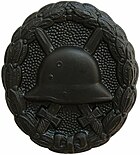
Back شارة الجرح Arabic Нагрудны знак «За раненне» Byelorussian Значка за раняване Bulgarian Insígnia de Ferit (Alemanya) Catalan Odznak za zranění Czech Verwundetenabzeichen German Medalla de herido (Alemania) Spanish Haavatu märk Estonian نشان زخم Persian Haavoittumismerkki Finnish
| Wound Badge Verwundetenabzeichen | |
|---|---|
  1918 & 1945 version in black | |
| Type | Badge |
| Awarded for | wounds whilst on active service |
| Presented by | Imperial German Army (WWI) German Army (WWII) |
| Eligibility | Military personnel and after 1943 to civilians, as well |
| Campaign(s) | World War I & World War II |
| Status | Obsolete |
| Established | 3 March 1918 |
| Last awarded | 1945 |
| Total | 5 million awarded during World War II |
The Wound Badge (German: Verwundetenabzeichen) was a German military decoration first promulgated by Wilhelm II, German Emperor on 3 March 1918, which was first awarded to soldiers of the German Army who were wounded during World War I. Between the world wars, it was awarded to members of the German armed forces who fought on the Nationalist side of the Spanish Civil War, 1938–39, and received combat related wounds.[1] It was awarded to members in the Reichswehr, the Wehrmacht, SS and the auxiliary service organizations during World War II. After March 1943, due to the increasing number of Allied bombings, it was also awarded to civilians wounded in air raids.[2] It was awarded when the wound was the result of enemy hostile action.[2] In 1957, the West German government authorized a denazified[3] (Swastika removed) version of the basic (black, silver, & gold) badges for wear on the Bundeswehr uniform, among other certain Nazi-era wartime awards.[4]
- ^ Angolia 1987, p. 256.
- ^ a b Angolia 1987, p. 259.
- ^ "Bundesministerium der Justiz: Gesetz über Titel, Orden und Ehrenzeichen, 26.7.1957. Bundesgesetzblatt Teil III, Gliederungsnummer 1132-1". German Federal law. Retrieved 2020-09-04.
- ^ "Dienstvorschriften Nr. 14/97. Bezug: Anzugordnung für die Soldaten der Bundeswehr. ZDv 37/10. (Juli 1996)". German Federal regulation. Retrieved 2020-09-04.